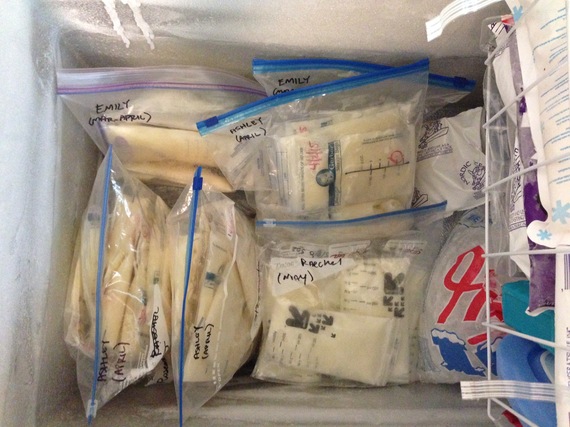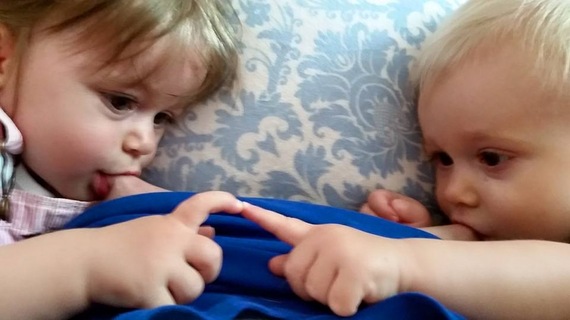"Milk sharing" is a colloquialism for the gift economy of expressed breast milk. Human Milk 4 Human Babies, Eats on Feets, and hundreds of other online sites connect families who are milk sharing. Milk sharing arrangements also take place offline within families, among friends, and through local community-based social networks.
Although most people have heard about online milk sharing, there are many misconceptions about what parents are doing, how they are doing it, and why.
Our paper "Human Milk Sharing Practices in the U.S.," which was recently published in Maternal & Child Nutrition, busts some common milk sharing myths.
MYTH 1: MILK SHARING IS ALL ABOUT THE MONEY
Milk sharing is often confused with milk selling. People talk about the two as if they are one in the same and carry equivocal risks. But, are they the same?
Only 2% of donors in our study reported selling their breast milk, and just 9% of recipients reported buying breast milk (and that includes purchase from a milk bank).
We argue that milk sharing is distinct from milk selling, precisely because money is not fundamentally driving these practices. Our findings are consistent with other studies, which report that the primary motivations for milk sharing involve helping others and seeking a better alternative to formula feeding.
MYTH 2: MILK SHARING IS CASUAL, LIKE CASUAL SEX
You may have heard people refer to milk sharing as casual milk sharing. This term likens milk sharing to casual online dating, a practice that may lead to anonymous, and perhaps risky, sexual encounters. It also implies that milk sharing is practiced without regard for the possible risks.
So, is milk sharing casual?
Out of 867 respondents, there were zero cases of anonymous milk sharing. 29% percent shared only with family members or friends. 91% of recipients reported asking donors screening questions. Recipients who reported buying milk reported screening and meeting donors in person. When milk was shipped rather than delivered in-person, donors who were not a family member or friend were always screened. Informed milk sharing is a better word to describe what parents are doing.
MYTH 3: PARENTS ARE SEEKING MILK FOR SICK BABIES
Another common misconception is that parents are mostly seeking shared milk for medically fragile babies.
Parents in our study were seeking milk for healthy, full-term babies. 83% of recipient infants were born >37 weeks gestation and healthy. The average age of recipient infants was 7 months old. Around 10% of both donors and recipients reported also giving or receiving milk through a milk bank.
Along with others, we argue that milk sharing functions to increase accessibility to donor breast milk for healthy babies. Milk sharing empowers parents to follow WHO recommendations for exclusive breast milk feeding when a mother's or parent's own milk is insufficient or not available.
MYTH 4: PARENTS DON'T UNDERSTAND THE RISKS
The idea that milk sharing is casual is tied up with the assumption that parents are either unaware of, or are not concerned with, the possible dangers. The main risks of milk sharing are bacterial contamination through handling practices, contamination with maternal medications and substances, and disease transmission.
We asked recipient parents to indicate how concerned they were with milk sharing risks generally. Then we asked them to indicate their concern with specific types of risks. We also evaluated the association between being worried about a risk and asking a donor related screening questions.
Parents were most concerned with medications in milk, diseases, and a donor's alcohol and tobacco use. Parents were more likely to ask screening questions about specific risks when their level of concern was high. They were also more likely to screen strangers.
MYTH 5: SHARING MILK IS DIRTY & DANGEROUS
Media coverage of milk sharing continues to reinforce the idea that breastmilk is dirty, and that formula is clean and safe. The reality is that there are relative risks, benefits, and costs associated with any type of infant feeding option, even formula feeding.
Expressed human milk is resistant to bacterial contamination under a variety of expression, freeze-thaw, and handling conditions. Good hygiene is important to reducing risks of contamination when expressing and storing human milk. Most mothers in the U.S. report following recommended practices. But, if frozen milk thaws during transit, when it's being shipped, for example, this could lead to a proliferation of bacteria.
In our study 96% of milk sharing occurred locally with face-to-face drop offs and pick ups, which may reduce the risk of milk being contaminated en route (a hypothesis we are currently testing). Also, 12% of donors in our study reported breastfeeding a recipient baby, a practice that eliminates risks of unhygienic storage and handling. A milk sharing study in Central Florida found even higher rates of shared breastfeeding.
Saying there are a lot of bacteria in expressed milk does not say much about the risks of milk sharing, though. The definition of bacterial contamination is somewhat contentious as human milk naturally contains beneficial bacteria. Infants are exposed to bacteria in the womb, during birth, through contact with normal flora of a caregiver's skin, and in their everyday environments. The bacteria found in breast milk are essential to the development of a healthy neonatal gut microbiome and immune system. Scientists have yet to determine what levels of bacterial growth lead to adverse health outcomes in healthy, immunocompetent infants.
With regard to the risks of exposure to medications and substances in milk, it's helpful to understand what the recommendations are for mothers who are breastfeeding their own healthy, full-term babies. Most medications are considered safe while breastfeeding, and neither smoking nor consuming caffeine or alcohol are considered reasons not to breastfeed.
The risks of disease transmission via expressed breast milk are also relatively low. This is one reason there are so few diseases that are considered incompatible with breastfeeding. It is also why milk sharing between a healthy donor and a healthy infant is supported by WHO-UNICEF.
HIV/AIDS arguably causes the most concern, because of how complex transmission is. There are evidence-based recommendations for reducing transmission of HIV via breastfeeding and expressed milk. One is knowing a donor's HIV status. In the U.S. mothers are tested for HIV during pregnancy to reduce rates of perinatal transmission, and HIV+ mothers are discouraged from breastfeeding. HIV testing for anyone who is sharing their milk with others, throughout the time they are milk sharing, is also important. Milk may be flash heated to kill HIV, as demonstrated below by Dr. Israel-Ballard:
The CDC notes that freezing may also attenuate the risk of HIV transmission.
Just under 10% of recipient parents in our study reported flash heating milk. These were parents who were highly concerned with disease transmission. 96% of respondents reported giving or receiving frozen expressed breast milk.
Key Takeaways
Milk sharing is often framed as dirty, dangerous, or strange. Despite the social stigma and health warnings, however, online milk sharing communities continue to expand.
Parents in our study reported making informed decisions about milk sharing, and taking specific actions to reduce those risks.
Families who are milk sharing need support, not judgment. When we understand milk sharing practices, health workers can find better ways to support parents in making informed infant feeding decisions and facilitate safer milk sharing.
You can read the full text of our paper here!
Disclaimer: Any ads that may appear along with this post are in no way the author's endorsement of the ad, the products or services promoted in the ads, or any other entities associated with the ads.


